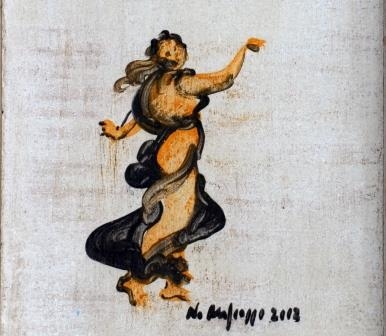Here we have fantastic characters, giants, men travelling over space to re-evoke ancient and very noble deeds. Many a time such figures are almost evanescent, being painted with a material that is perceived as trasparent but is actually very solid and brilliant. Everything is airy, dreamlike, as if seen from the remoteness of a space and time coming from another world, and yet accompaning our steps here and now. Migliozzi is perhaps the most effective demonstration of how philology and poetry might be considered as sisters. However, could we speak of poetry as if it were really a science? Yes, of course, from the point of an artist like Migliozzi. Even better, it is in such a precision, in such a special analysis of matter and iconography that lies the plain and yet solemn appeal of Migliozzi’s creations, indeed the result of the rigour of philology joined with the freedom of imagination. The figure of Homer, the divine poet, seen on a beautiful lava stone, radiates its influence on all the other images that seems to originate from himself. As a subject matter we often have poetry, time and time’s action, Ovidian love, Ulysses’s journey, which is the emblem par excellence of this vision of art, inspiration, rest, understanding, masks, prophetic cries. The latter is a sort of commentary on the other Pompeian images reaching their climax in the figure of the great intercessor who seems to beget his characters just to project them into the poetic universe of art itself, mirrored also in Migliozzi’s excellent ceramics, the necessary complement of an exhibit which is essentially a magnificent self-portrait. It allows us to look at an author who has conceived his entire work as a huge prophecy, meant to do good for its spectators and to prepare them for a journey in time, a journey yielding wellbeing and deep gratification.
Claudio Strinati

